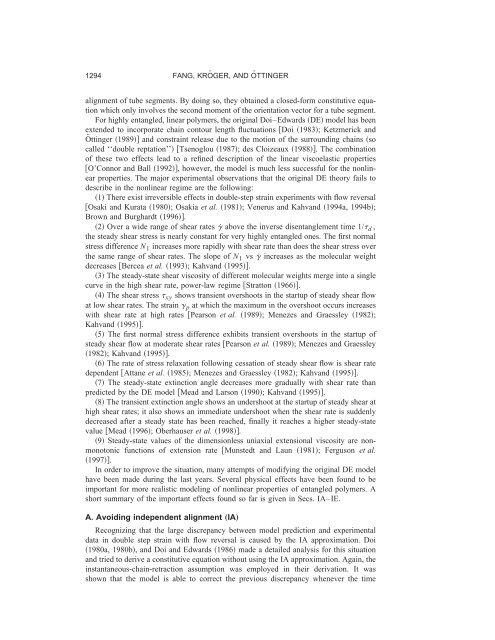View - Martin Kröger - ETH Zürich
View - Martin Kröger - ETH Zürich
View - Martin Kröger - ETH Zürich
Create successful ePaper yourself
Turn your PDF publications into a flip-book with our unique Google optimized e-Paper software.
1294 FANG, KRÖGER, AND ÖTTINGER<br />
alignment of tube segments. By doing so, they obtained a closed-form constitutive equation<br />
which only involves the second moment of the orientation vector for a tube segment.<br />
For highly entangled, linear polymers, the original Doi–Edwards DE model has been<br />
extended to incorporate chain contour length fluctuations Doi 1983; Ketzmerick and<br />
Öttinger 1989 and constraint release due to the motion of the surrounding chains so<br />
called ‘‘double reptation’’ Tsenoglou 1987; des Cloizeaux 1988. The combination<br />
of these two effects lead to a refined description of the linear viscoelastic properties<br />
O’Connor and Ball 1992, however, the model is much less successful for the nonlinear<br />
properties. The major experimental observations that the original DE theory fails to<br />
describe in the nonlinear regime are the following:<br />
1 There exist irreversible effects in double-step strain experiments with flow reversal<br />
Osaki and Kurata 1980; Osakia et al. 1981; Venerus and Kahvand 1994a, 1994b;<br />
Brown and Burghardt 1996.<br />
2 Over a wide range of shear rates ˙ above the inverse disentanglement time 1/ d ,<br />
the steady shear stress is nearly constant for very highly entangled ones. The first normal<br />
stress difference N 1 increases more rapidly with shear rate than does the shear stress over<br />
the same range of shear rates. The slope of N 1 vs ˙ increases as the molecular weight<br />
decreases Bercea et al. 1993; Kahvand 1995.<br />
3 The steady-state shear viscosity of different molecular weights merge into a single<br />
curve in the high shear rate, power-law regime Stratton 1966.<br />
4 The shear stress xy shows transient overshoots in the startup of steady shear flow<br />
at low shear rates. The strain p at which the maximum in the overshoot occurs increases<br />
with shear rate at high rates Pearson et al. 1989; Menezes and Graessley 1982;<br />
Kahvand 1995.<br />
5 The first normal stress difference exhibits transient overshoots in the startup of<br />
steady shear flow at moderate shear rates Pearson et al. 1989; Menezes and Graessley<br />
1982; Kahvand 1995.<br />
6 The rate of stress relaxation following cessation of steady shear flow is shear rate<br />
dependent Attane et al. 1985; Menezes and Graessley 1982; Kahvand 1995.<br />
7 The steady-state extinction angle decreases more gradually with shear rate than<br />
predicted by the DE model Mead and Larson 1990; Kahvand 1995.<br />
8 The transient extinction angle shows an undershoot at the startup of steady shear at<br />
high shear rates; it also shows an immediate undershoot when the shear rate is suddenly<br />
decreased after a steady state has been reached, finally it reaches a higher steady-state<br />
value Mead 1996; Oberhauser et al. 1998.<br />
9 Steady-state values of the dimensionless uniaxial extensional viscosity are nonmonotonic<br />
functions of extension rate Munstedt and Laun 1981; Ferguson et al.<br />
1997.<br />
In order to improve the situation, many attempts of modifying the original DE model<br />
have been made during the last years. Several physical effects have been found to be<br />
important for more realistic modeling of nonlinear properties of entangled polymers. A<br />
short summary of the important effects found so far is given in Secs. IA–IE.<br />
A. Avoiding independent alignment „IA…<br />
Recognizing that the large discrepancy between model prediction and experimental<br />
data in double step strain with flow reversal is caused by the IA approximation. Doi<br />
1980a, 1980b, and Doi and Edwards 1986 made a detailed analysis for this situation<br />
and tried to derive a constitutive equation without using the IA approximation. Again, the<br />
instantaneous-chain-retraction assumption was employed in their derivation. It was<br />
shown that the model is able to correct the previous discrepancy whenever the time





